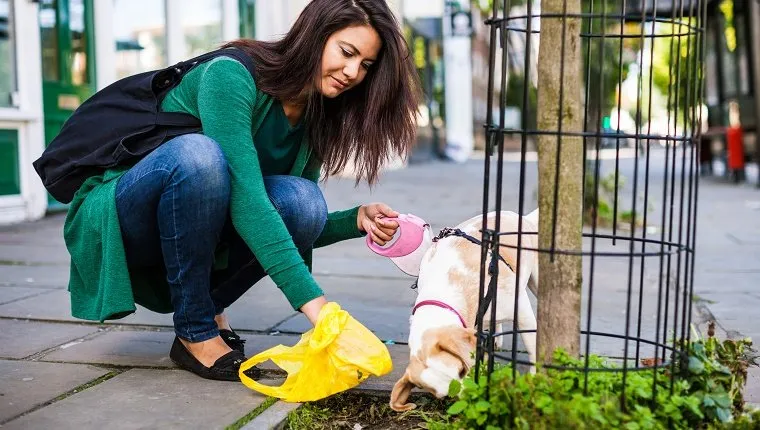As dog owners, we often find ourselves monitoring our furry friends’ health in various ways, and one of the most revealing indicators is their poop. Yes, you read that right! Your dog’s poop can provide valuable insights into their digestive health, overall well-being, and even potential underlying issues. In this comprehensive guide, we’ll explore the different types of dog poop, what they signify, and when you should be concerned.
Understanding Dog Poop Basics
Before we dive into the specifics, let’s cover the basics of what constitutes healthy dog poop:
Color
Normal dog poop ranges from brown to shades of green, depending on diet and bile content.
Consistency
Healthy poop should be firm, moist, and easy to pick up.
Frequency
Dogs typically poop 1-3 times a day, but this can vary based on age, diet, and activity level.
Types of Dog Poop and Their Meanings
Type 1: Normal
Appearance
Firm, moist, and well-formed.
What it means
Your dog is likely digesting their food properly, and their gastrointestinal tract is functioning well.
Type 2: Soft
Appearance
Slightly softer than normal, but still retains its shape.
What it means
This could indicate mild digestive upset or a change in diet. Monitor closely for any other symptoms.
Type 3: Runny
Appearance
Watery consistency, no defined shape.
What it means
Runny poop may suggest diarrhea, which can be caused by dietary indiscretion, infections, or other health issues. Consult your vet if it persists for more than 24 hours or is accompanied by other symptoms like vomiting or lethargy.
Type 4: Mucus-covered
Appearance
Poop with a coating of mucus.
What it means
Mucus in stool can indicate inflammation in the colon or other gastrointestinal issues. It’s important to seek veterinary advice for proper diagnosis and treatment.
Type 5: Bloody
Appearance
Streaks of blood or red coloration in the stool.
What it means
Bloody stool can be a sign of serious conditions like parasites, infections, or internal injuries. Immediate veterinary attention is necessary.
Factors Influencing Dog Poop
Diet
The food your dog eats has a significant impact on their poop:
High-Fiber Diet
Can result in larger, bulkier stools.
Change in Diet
Sudden changes can lead to digestive upset and changes in stool consistency.
Table Scraps
Human foods can sometimes cause diarrhea or other gastrointestinal issues due to their richness or ingredients like spices.
Health Conditions
Various health conditions can affect your dog’s poop:
Parasites
Intestinal parasites like worms can cause diarrhea and other digestive disturbances.
Infections
Viral, bacterial, or protozoal infections can lead to diarrhea and other symptoms.
Pancreatitis
Inflammation of the pancreas can result in diarrhea and other digestive issues.
When to See the Vet
While occasional changes in stool are normal, certain signs indicate a visit to the vet is necessary:
Persistent Diarrhea
Lasting more than 24 hours or accompanied by other symptoms.
Blood in Stool
Always requires immediate veterinary attention.
Lethargy, Vomiting, or Loss of Appetite
These symptoms along with changes in stool can indicate a serious underlying issue.
Conclusion
Your dog’s poop is a valuable indicator of their digestive health and overall well-being. By paying attention to its color, consistency, and any accompanying symptoms, you can better understand your dog’s health status and take appropriate action when needed. Regular vet check-ups, a balanced diet, and prompt attention to changes in stool can help keep your furry friend happy and healthy for years to come.
What does dog poop analyze?
Dog poop analysis can reveal valuable insights into your pet’s health, including their digestive efficiency, potential dietary issues, and sometimes even signs of underlying health conditions.
Why is my dog’s poop covered in sausage skin?
The appearance of “sausage skin” or a mucus coating on your dog’s poop can indicate inflammation or irritation in the intestines, possibly due to digestive upset or infection.
Why is it important to clean up dog poop?
Cleaning up dog poop is crucial for preventing the spread of parasites, bacteria, and diseases that can harm other pets, wildlife, and even humans. It also helps keep public spaces clean and safe.
What is a fact about dog poop?
A fascinating fact about dog poop is that its odor is partly due to the presence of bacteria that break down proteins in the intestines, producing distinct smells.
What bacteria does dog poop have?
Dog poop can harbor various bacteria, including E. coli, Salmonella, and Campylobacter, which can pose health risks to humans and other animals if not properly handled or disposed of.
What makes dog poop shiny?
Dog poop may appear shiny due to the presence of mucus or excess moisture, which can give it a glossy or wet appearance.
What does fat look like in dog poop?
Fat in dog poop can appear as a shiny, greasy film or as yellowish-orange spots in the stool, indicating issues with fat absorption or digestion.
Why do dogs peel out after pooping?
Dogs might “peel out” or kick their feet after pooping to mark their territory with scent glands located in their paws, signaling to other dogs in the area.
Does dog poop attract mosquitoes?
Yes, dog poop can attract mosquitoes because it provides an ideal breeding ground for them, especially in warm and humid conditions.
Why do dogs inspect their poop?
Dogs may inspect their poop as part of their instinctual behavior to gather information about their own health, as well as to identify other dogs in their territory based on scent.
- Best Clay Alternatives for 2025 - April 19, 2025
- Best Seamless.ai Alternatives for 2025 - April 19, 2025
- Best UpLead Alternatives for 2025 - April 18, 2025



